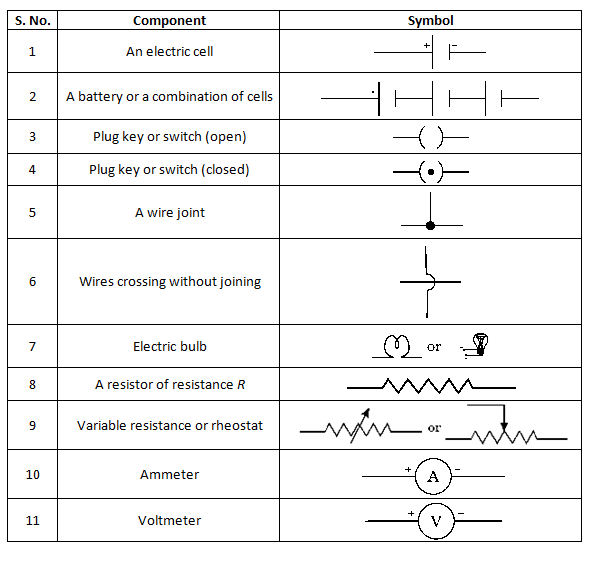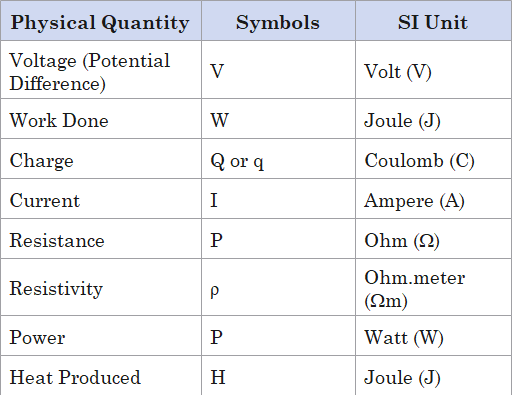In this article, we will try to provide a list of all physics electric current formulas for class 10 science chapter 12 along with a pdf download.
Other important links you might be interested in are
The movement of charge in a conductor from the positive terminal to the negative terminal is referred to as electricity. Electricity has a wide range of uses and applications. It serves as a medium for supplying power to electrical devices. We already know that the flow of charge generates current, which we call electricity.
Electric Current Formula
To understand how electricity is produced, we must first understand the various basic parameters associated with it, such as voltage, current, resistance, conductivity, and the relationships between these quantities.
Symbols and Notations
Physical quantities, symbols, and SI Units
Symbols for commonly used electrical components

Formulas of electricity
Given below are all the formulas used for class 10 electricity chapter.
- Charge q on a body is always denoted by
$q = ne$
where n = any integer positive or negative and $e =1.602 \times 10^{-19} C$ i. e., charge on an electron or proton. - $Work\; done = charge \times potential $ or potential difference
Mathematically,
$W=qV=q(V_2V_1)\; Joule$ - $Electric\; Current = \frac{charge}{time}$
Or,
$I=\frac{q}{t}\;Ampere$ - Ohm’s Law
$Resistance=\frac{potential\; difference}{current}$
Or,
$R=\frac{V}{I}$ - Resistance in terms of resistivity
$R=\frac{\rho l}{A}$ - Resistance in series combination
$R_s=R_1+R_2+R_3+…..$ - Resistance in parallel combination
$\frac{1}{R_p}= \frac{1}{R_1}+ \frac{1}{R_2}+ \frac{1}{R_3}+…..$ - Electrical Power
$P=VI=I^2R=\frac{V^2}{R}$ - Power in Series
$\frac{1}{P_s}= \frac{1}{P_1}+ \frac{1}{P_2}+ \frac{1}{P_3}+…..$ - Power in parallel
$P_p=P_1+P_2+P_3+…..$ - Electrical Energy
$E-Vit=I^2Rt=\frac{V^2}{R}t$ - Heat produced
$H-Vit=I^2Rt=\frac{V^2}{R}t$
Solved Examples
Question 1
When a 12 V battery is connected across an unknown resistor, there is a current of 2.5 mA in the circuit. Find the value of the resistance of the resistor.
Solution
Here,
Battery Voltage $V= 12 V$
Current in circuit $I=2.5mA=2.5\times 10^{-3}A$
Resistance of the resistor $R=?$ is to be calculated
We know that from Ohm’s Law
$R=\frac{V}{I}$
Putting in the values we get
$R=\frac{12V}{2.5\times 10^{-3}A}$
$=4.8\times 10^{3}VA^{-1}=4.8\times 10^{3}\Omega $
Question 2
An electric heater of resistance $8\Omega$ draws 15 A from the service mains for 2 hours. Calculate the rate at which heat is developed in the heater.
Solution
It is given in the question that
Heater resistance $R=8\Omega$
Current drawn, $I=15 A$
Time for which current is drawn
$t=2h=2\times 60\times 60 \;sec=7200\; sec$
Rate of heat developed $P=?$ which is to be calculated
We know that
Rate of heat developed = rate at which power is consumed.
$P=I^2R$
Putting in the value we get,
$P=(15 A)^2\times 8\omega=1800W$
The rate of heat developed is
$P=1800 J/s$ Test Yourself on questions based on these formulas
Test Yourself
General Instructions
- Your test contains multiple-choice questions with only one answer type of questions. There are a total of 5 questions
- This is a 10 min test. Please make sure you complete it in the stipulated time
- You can finish this test any time using the ‘View Results‘ button.
Electricity Formula Chart PDF Download
Class 10 Electricity formulas PDF Download
Use this image to share this page on social media

 Skip to content
Skip to content

op
thanks
Excellent understanding, best quality questions and there solutions . External support of brilliant understanding
Good article but small typo in the Physical quantities, symbols, and SI Units table.
Symbol for resistance should be R not P
helps a lot
really helpful tomorrow is my exam now this gives me confidence